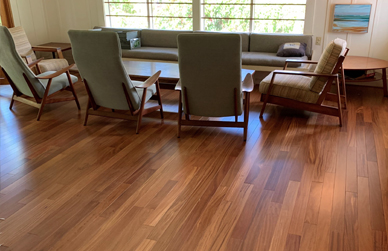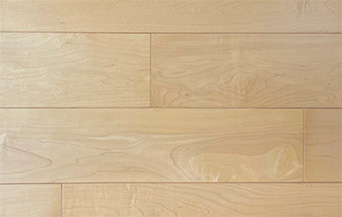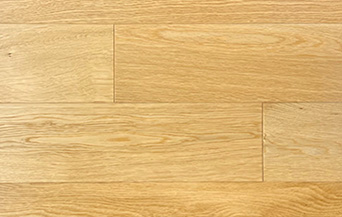

Tradition Collection
Solid Wood
Solid Wood is a wood floor that has been milled from one solid piece of wood with a tongue & groove on all four sides. The standard thickness is ¾” and is available in various widths and lengths. Solid wood is a lifetime product because it can be sanded and refinished 3-4 times. Wood flooring is available in both Unfinished and Prefinished. Traditionally, solid wood was installed as an unfinished plank that must be installed, sanded, sealed, and finished onsite. Solid wood must be either nailed or glued down on or above grade. Many people like the look of unfinished wood because it has no bevels between planks. This gives the wood floor a smooth, seamless look. It can also be customized with either a stain or whitewash before finishing the floor. The downside to unfinished solid wood is the installation takes much longer and is expensive. In addition, the 2-3 layers of finish that’s applied onsite cannot beat 5-7 layers of UV cured factory finish.
Solid Wood flooring is available in a variety of domestic and exotic species.
- 3/4” thick
- Available in 3-1/4” and 5” widths
- Random lengths up to 7’
- Micro bevel on 4 sides
- 7 layers of polyurethane with aluminum oxide

Ipe (Brazilian Walnut)
Origin: Central and South America Janka Hardness: 3620
Ipe is one of the hardest wood species, it’s excellent in high-traffic areas and often used as decking. There aren’t many species denser and stronger than Ipe Hardwood flooring. Its dense cell structure serves as a natural deterrent to termites and molds, ensuring that your floor will last long. Not only known for its durability but also for its high color variation; including medium-chocolate brown, deep reds, as well as olive tones. Its natural graining includes straight and irregular patterns, creating a one-of-a-kind visual for your space.

Cumaru (Brazilian Teak)
Origin: Central and South America Janka Hardness: 3540
Cumaru is another very hard exotic wood species. It has an irregular, wavy, interlocked grain and colors including light-medium browns and honey gold. Over time, with exposure to light, the range of colors will even out and makes for an even more uniform appearance in color. For that reason and its durability, it has remained our best seller for many years.

Tigerwood
Origin: South America Janka Hardness: 2160
Tigerwood’s graining is what makes it so unique and easy to identify. Initially, tigerwood is a pale gold or blonde in color with dark, thick striping. Usually, 30-40% of the boards will feature dramatic striping. This is another species that is quite photosensitive and will change to a deeper golden-red tone making the stipes also recess a bit.

Maple
Origin: North America Janka Hardness: 1450
Maple is one of the hardest domestic hardwood species, making it perfect for high-traffic spaces—think Basketball courts and bowling alleys! Maple’s color has a warm hue and is typically a very pale, creamy white color with a light shade difference between boards. The graining is also very light and sometimes not even noticeable. Perfect for a timeless, light, and clean look floor.

White Oak
Origin: North America, Europe Janka Hardness: 1360
White oak is one of the most popular domestic species of wood and has recently increased in popularity. This domestic wood is durable and very popular for residential applications. White oak starts as an ashy light beige color with medium brown grain patterns that vary from one board to the next. These grain patterns tend to mellow out as the wood ages. Oak is very diverse; it can look traditional, rustic, and contemporary with the aid of stains, whitewashes, and texture treatments.

Red Oak
Origin: North America, Europe Janka Hardness: 1260
Red oak was the most common wood flooring for many years. Its warm tones range in color from creamy pink and golden red to rusty brown. It also is known for having visible graining and color variations from plank to plank. Just like white oak, red oak takes stains and whitewashing well.

